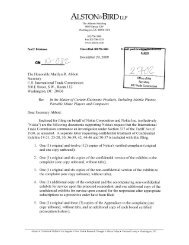lg optimus g pro - AOL.com
lg optimus g pro - AOL.com
lg optimus g pro - AOL.com
Create successful ePaper yourself
Turn your PDF publications into a flip-book with our unique Google optimized e-Paper software.
DISTRO 03.08.13 THE RACING LINE: EXPLORING NASCAR’S TECHNOLOGICAL DICHOTOMY<br />
QUESTION:<br />
“ If you could<br />
add any piece<br />
of technology<br />
to NASCAR<br />
for the 2013<br />
season, what<br />
would it be?”<br />
SCOTT MILLER<br />
EXECUTIVE VP OF<br />
COMPETITION AT<br />
MICHAEL WALTRIP<br />
RACING<br />
TRACTION CONTROL<br />
“Not necessarily for<br />
Daytona, but for our<br />
season in general,<br />
I’d <strong>pro</strong>bably have to go<br />
with traction control.”<br />
tionwide and, at the top, the Sprint Cup. There are separate<br />
sanctioned stock car series in Mexico, Canada and Europe,<br />
plus regional series on the eastern and western coasts of the<br />
United States. Finally, for those who prefer road courses,<br />
there’s the Grand-Am series, which itself campaigns four<br />
real-world racing series (plus a fifth, virtual one, the iRacing.<strong>com</strong><br />
Online Sports Car Series) and next year will grow to<br />
consume the American Le Mans Series.<br />
NASCAR racing is, then, big business, and that’s not<br />
the half of it. For each of the 43 drivers that took the green<br />
flag at the 2013 running of the Daytona 500, hundreds of<br />
other souls played a part in getting them onto the track,<br />
ranging from the folks who clean the shops back in Wilkes<br />
County, N.C., to the guys and gals who handle the frantic<br />
wheel changes in the pit stops. (Most of whom, by the<br />
way, are scouted out of college sports <strong>pro</strong>grams for their<br />
strength, speed and reflexes.)<br />
However, there’s a new breed of crew member at the<br />
track, often sporting bespectacled faces and distinctly<br />
English accents. They’re engineers, and a surprising number<br />
have made the transition to NASCAR from what is<br />
considered to be the pinnacle of motorsport technology:<br />
the international Formula One series.<br />
“Formula One has always been based off of engineering,”<br />
Kenny Wallace, a longtime NASCAR personality<br />
and current driver of the #29 RAB Racing Toyota, told<br />
us. “This is still a new world for us, but now it’s here for<br />
real. Twenty years ago it was ‘Hey, I got an engineer.’ ‘Oh,<br />
what’s he do?’ ‘He tells ya what time you ran.’ Now it’s<br />
here for real... It’s so real now, that if you don’t have this,<br />
you’re behind.”<br />
Indeed, on race mornings you’ll see engineers frantically<br />
wielding a variety of tools, but the humble laptop (and,<br />
on some more <strong>pro</strong>gressive teams, Microsoft’s Surface tablet)<br />
has be<strong>com</strong>e a recent addition thanks to the introduction<br />
of electronic fuel injection (EFI) to the cars in 2012.<br />
EFI replaces clunky, <strong>com</strong>plicated carburetors, the sort that<br />
hasn’t been seen in <strong>pro</strong>duction cars in the United States<br />
for 20 years. (Similarly, leaded fuel was banned from US



